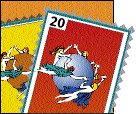

 |  The world of philatelyHistory of the postage stamp |
 |
From the start of postal services throughout the world, a problem arose which lasted several centuries: who should pay the postage the sender or the recipient? Although methods often varied from one country to another, it remained the custom for a long time for this task to be that of the recipient. But what if the receiver exercised his right to refuse the letter and not pay the postage? Many attempts were made to find a solution which would guarantee that the postal organizations would receive the tax that was their due. In France, a certain Monsieur de Velayer had the idea of creating a small post office and in 1653, he offered his customers small pieces of paper with the mention receipt for the payment of transport. These were to be put into letterboxes that were emptied at more or less regular hours and then sent to their destinations. In 1814 the Sardinian postal service took up M. de Velayer's idea and relaunched the stamped paper principle, but again it was used only for a short time. It was not until 6 May 1840 that the pre-payment of postage in the form of an adhesive receipt took off. The postage stamp was born when English post offices initiated the sale of the first stamps, the Penny Black stamp and the two Penny Blue stamp with the portrait of Queen Victoria, as well as two prepaid envelopes.
The method was rapidly adopted by other countries and the postage stamp thus found its reason for existence it had become a receipt for services to be rendered. The appearance of stamps on envelopes, postcards, bills and forms also gave rise to a new passion philately.
|
